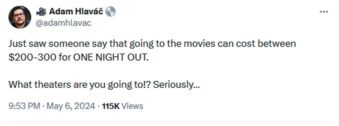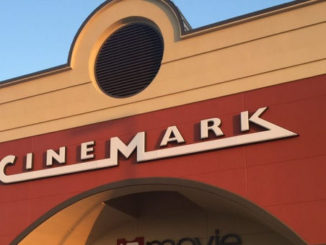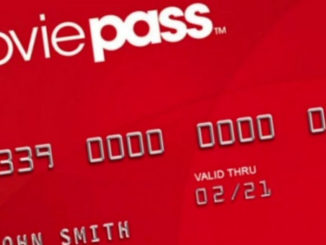
Recently, I saw a social media post where someone claimed that they were told them that a night out at the cinema costs anywhere between $200 and $300. Naturally, I raised my eyebrow at least a small bit at such a claim and indeed, the poster seemed to laugh off the claim. Certainly the only way to reach such an exorbitant amount of spending at a theater would involve buying tickets for far more than a family of four, as well as concessions and possibly an experiential upgrade such as 3-D IMAX or specialty seating, right?
 Indeed, there is a vast amount of missing information needed to even see how this person arrived at their alleged amount. The original poster does not even state whether or not that full amount was spent at the movie theater or if that included the cost for the entire evening out. Was this person factoring in such cost as babysitters (which might even be more than just bringing the kids along for the evening) or a meal elsewhere before arriving at the theater? What about gas and parking? Some of these are factors they might not even apply to all people. So without the knowledge of all the costs that add up to the amount that this person claimed they were spending – if indeed they were spending that much at all – we can probably disregard this particular statement as being anything else but of dubious anecdotal value.
Indeed, there is a vast amount of missing information needed to even see how this person arrived at their alleged amount. The original poster does not even state whether or not that full amount was spent at the movie theater or if that included the cost for the entire evening out. Was this person factoring in such cost as babysitters (which might even be more than just bringing the kids along for the evening) or a meal elsewhere before arriving at the theater? What about gas and parking? Some of these are factors they might not even apply to all people. So without the knowledge of all the costs that add up to the amount that this person claimed they were spending – if indeed they were spending that much at all – we can probably disregard this particular statement as being anything else but of dubious anecdotal value.
But all of that is not to say that the cost of going to the movies is not a concern among consumers. There are a lot of entertainment options out there vying for everyone’s limited budget. There are live concerts and sporting events, video games, music, comics and books. There are a number of experiential options out there such as amusement parks and travel. But nearly all of these other options have always been around to some extent. It just seems that every now and then people want to speak up about the squeeze they feel their wallets. And that’s understandable. (I don’t want to turn this into a discussion on the widening wage gap that many Americans are feeling.)
But the truth of it is, when factoring for inflation, the average price for a movie ticket has remained remarkably stable. According to a study published by Staistica, the $1.65 average price of a movie ticket in 1971 becomes $11.92 when adjusted for inflation to 2022 prices. And the average price of movie ticket in 2022? $10.53. So if anything, movie tickets have become slightly less expensive over the last fifty years.
Of course, it is a fairly well known fact that studios often take on average fifty percent of ticket sales, the rest going to the theaters. This leaves those theaters having to cover their expenses and make their own profits by carving out large profit margins on their concessions. According to CNBC, these concessions margins can be as high as 80% of what a theatergoer will pay when grabbing a snack and a soda. A similar report from The Hustle shows that for 2018, Cinemark had an 84% profit margin on its concessions. The total revenue that a theater can gain from concessions can vary anywhere between 35% and 45% of their total income. As such, the high price for a box of popcorn is tied directly to a theater’s continuing existence.
In essence, the movies themselves are basically a way to get customers in the door in order for the theater owners to sell them some popcorn. As has been noted by others, they’re not in the exhibition business so much as they are in the candy selling business. So if you want to keep the theatrical experience an ongoing option, it is probably best to grab yourself a bag of popcorn and a soda to wash it down with every now and then.
Now I know that I speak from a privileged position when talking about the cost of going to the movies. As a recognized film reviewer, I receive numerous invites to screenings as well as get press passes and special screenings at film festivals. Sometimes, I am offered the option of screening something online, from the comfort of my own couch. So for the most part, my movie-going cost is pretty much transportation and the occasional drink.

However, I don’t always have the ability to attend all of the screenings for the films I wish to cover, so I do sometimes find myself paying for a ticket out of my own pocket. As a back up plan to help mitigate that cost, I have a membership in the Cinemark movie club as well as a subscription to MoviePass. (Yes they’re back, with a more tenable business model.) These two services cost me a total of $22 a month , and lets me see anywhere between three and four movies a month. That is a savings of approximately thirty to forty dollars every month that I maximize those benefits.. This is also handy when I want to see a film again with friends. I also don’t order concessions every time I go to the movies, but if I were to, my Cinemark movie club membership does get me a discount at the snack counter. A glance at my phone’s Cinemark app shows that in the last twelve months I have saved approximately seventy dollars. AMC’s Stubs program is also good value for the money in terms of tickets and discount concessions and I would probably be enrolled in that if there was an AMC theater in my corner of the country.
So we come back to the original question – Is going to the movies to expensive? That is always a question one is ultimately going to have to answer for one’s self. Meanwhile, concert tickets are now averaging over $100 a pop and admission to an amusement park averages nearly $75 a person. And that is all before any of the possible secondary expenses – babysitters, transportation costs and any food or drink purchases – gets factored into what one will pay for the entire time out for those experiences. So for many folks, movies are still definitely good value for the money.




